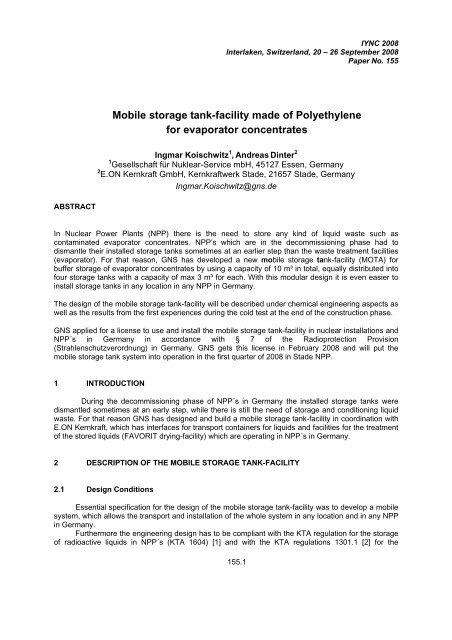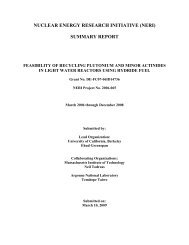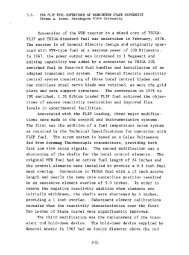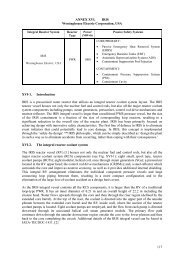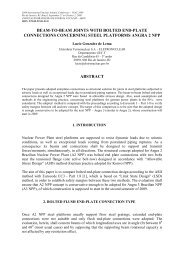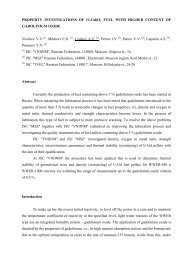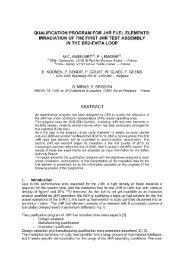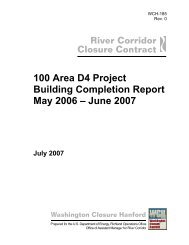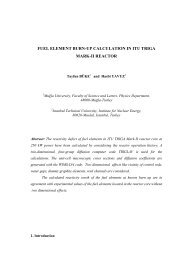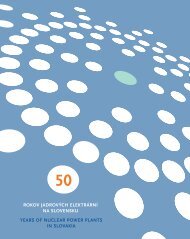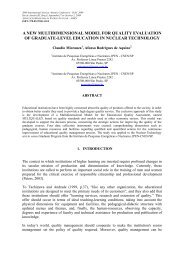Mobile storage tank-facility made of Polyethylene for evaporator ...
Mobile storage tank-facility made of Polyethylene for evaporator ...
Mobile storage tank-facility made of Polyethylene for evaporator ...
Create successful ePaper yourself
Turn your PDF publications into a flip-book with our unique Google optimized e-Paper software.
Proceedings <strong>of</strong> the International Youth Nuclear Congress 2008consideration <strong>of</strong> radiation protection in NPP´s to get the license to operate the mobile <strong>storage</strong> <strong>tank</strong><strong>facility</strong>in any NPP in Germany.The chemical engineering boundary aspects were given by the results <strong>of</strong> sample analysis <strong>of</strong>contaminated <strong>evaporator</strong> concentrates. The results <strong>of</strong> the said analysis are listed in table 1.Table 1: Analysis <strong>of</strong> <strong>evaporator</strong> concentrateDry substanceca. 200 kg/m³pH-value 6,5 – 7,5Specific density1,1 – 1,2 Mg/m³Chlorides1,6 – 2,0 kg/m³Activity concentration 1,0E11 Bq/m³Due to this analysis results it was possible <strong>for</strong> GNS to break new grounds by taken pipes, <strong>tank</strong>sand fittings <strong>made</strong> <strong>of</strong> different types <strong>of</strong> synthetic materials. The materials which were selected <strong>for</strong> thecomponents getting in contact with the <strong>evaporator</strong> concentrate, are listed in table 2.Storage <strong>tank</strong>sFilling pipeExtraction pipeBall valvesTable 2: Used materials<strong>Polyethylene</strong> HDPolyvinylchloridePolyvinylchloridePolyvinylchlorideThe consistency <strong>of</strong> different types <strong>of</strong> synthetic materials against radiation is documented in “DieBeständigekeit von Kunstst<strong>of</strong>f und Gummi” [3]. By consideration <strong>of</strong> the listed data’s [3] it is possible tocalculate the minimum time period <strong>for</strong> the <strong>storage</strong> <strong>of</strong> such radioactive liquids (as shown in table 1),until the synthetic material gets a degradation <strong>of</strong> its major characteristics. By absorbing radiation,synthetic materials are getting negative cross-links in their chemical structure which results, that thematerial is worse elastically.For the <strong>storage</strong> <strong>tank</strong>s which are designed to have permanent contact with the <strong>evaporator</strong>concentrate [according to table 1], GNS-calculations showed that it takes approximately 270 yearsuntil the limited value <strong>of</strong> radiation <strong>for</strong> <strong>Polyethylene</strong> is reached (without consideration <strong>of</strong> nuclidedecomposition). By consideration that the <strong>storage</strong> <strong>tank</strong>s are designed <strong>for</strong> an operating time <strong>of</strong> aboutthree years, there is a lot <strong>of</strong> safety be<strong>for</strong>e reaching the limit value <strong>of</strong> <strong>Polyethylene</strong>.2.2 DesignFor the buffer <strong>storage</strong> <strong>of</strong> radioactive liquids the mobile <strong>storage</strong> <strong>tank</strong>-<strong>facility</strong> has a capacity <strong>of</strong>more than 10 m³ in total. The total capacity is based on the maximum transport-volume <strong>of</strong> the TC10GNS-transport-container <strong>for</strong> radioactive liquids.The mobile <strong>storage</strong> <strong>tank</strong>s need a installation area <strong>of</strong> 6,5 m x 4 m x 4 m (lxwxh) <strong>for</strong> the wholesystem without its control unit.The mobile <strong>storage</strong> <strong>tank</strong>-<strong>facility</strong> consists <strong>of</strong> four single <strong>tank</strong>s with a maximum capacity <strong>of</strong> 3 m³by each. The <strong>tank</strong>s are fixed on massive steel-podiums and are removable to transport the system toother NPP´s or <strong>for</strong> maintenance work. For lower doorways each steel-podium could be separated intotwo parts. The steel podiums are coated with a decontaminable coating-system. The minimum height<strong>of</strong> the installation area is about 4 m.The <strong>for</strong>m stability <strong>of</strong> the <strong>tank</strong>s is supported by three pr<strong>of</strong>iles <strong>of</strong> steel, which are wrappedaround the side wall <strong>of</strong> each <strong>tank</strong>. Additional the <strong>tank</strong>s are fixed on the steel-podiums by connectingthe wrapped pr<strong>of</strong>iles with a stainless steel selection to the podium on every <strong>tank</strong>-corner. Figure 1 givesan overview <strong>of</strong> the mobile <strong>storage</strong> <strong>tank</strong>s installed in the NPP Stade in December 2007.155.2
Proceedings <strong>of</strong> the International Youth Nuclear Congress 2008When the charging level <strong>of</strong> the first <strong>storage</strong> <strong>tank</strong> reaches nearly 95%, the automatic control-system(PLC) <strong>of</strong> the mobile <strong>storage</strong> <strong>tank</strong>-<strong>facility</strong> switches the fitting positions automatically to the second <strong>tank</strong>(and so on). For the measures <strong>of</strong> error-free charging levels, a microwave measurement is installed ineach <strong>storage</strong> <strong>tank</strong>.For the prevention <strong>of</strong> the sedimentation <strong>of</strong> the solid ingredients, an electricity driven agitator isinstalled in every <strong>storage</strong> <strong>tank</strong>. In addition to the agitators, one circulation pump which is connectedwith tubes in every <strong>tank</strong>, is the back up installation to ensure a homogenious distribution <strong>of</strong> theingeredients in the liquid <strong>evaporator</strong> concentrates.The exctraction <strong>of</strong> <strong>evaporator</strong> concentrate from the <strong>storage</strong> <strong>tank</strong>s into the connectedconditioning system will be operated with vakuum technology, installed in the GNS drying-<strong>facility</strong>FAVORIT. In every step the positioning <strong>of</strong> the fittings are automatically switched and controlled by thePLC-system after program-selection by the operator.If the <strong>evaporator</strong> concentrate is totally extracted, each <strong>tank</strong> can be flushed by injectingdeionised water with a high pressure injector in the cap <strong>of</strong> every <strong>storage</strong> <strong>tank</strong>. By pumping theinjecting deionised water circular in the <strong>storage</strong> system and disposing in the sewage system after, theremaining dose rate <strong>of</strong> the <strong>storage</strong> system can be lowered.2.4 AUTOMATIC CONTROL UNITThe automatic control unit (PLC) and its compressed-air unit are designed <strong>for</strong> the installationoutside the room <strong>of</strong> the <strong>storage</strong> <strong>tank</strong>s. The control unit is based on a Siemens S7-PLC-system with atouch-panel on the frontside <strong>of</strong> the cubicle. The complete mobile <strong>storage</strong> <strong>tank</strong>-<strong>facility</strong> will be operatedfrom this touch panel. For every program (filling, mixing, extraction, flushing) a separate window canbe opened by touching the selection button on the panel frontside.Control unitCompressed-air unitFigure 3: Control- and compressed-air unit, installed in NPP Stade, Germany 2007By selection <strong>of</strong> the main program, the process flow-sheet <strong>of</strong> the mobile <strong>storage</strong> <strong>tank</strong>-<strong>facility</strong> isshown on the panel. The current status <strong>of</strong> every electronical component is shown by green or redsymbols on the screen.The <strong>storage</strong> system can be controlled by two different ways. For normal operationautomatically controlled programs <strong>for</strong> filling, mixing, extraction and flushing are established. Everyprogram is automatically interrupted by reaching stored charging levels (filling, extraction, flushing) orfixed time targets (period <strong>of</strong> mixing). In case any malfunction, an accustic and visual alarm signal isgenerated by the PLC-system. For this functionality <strong>of</strong> safety, every component is checked by thePLC-system several times per second.155.4
Proceedings <strong>of</strong> the International Youth Nuclear Congress 2008Storage <strong>tank</strong>sTakeover-stationFigure 3: Overview program, Control-unit mobile <strong>storage</strong> <strong>tank</strong>sIf any malfunction is detected, the <strong>storage</strong> system can be operated by hand. The hand controllevel is protected with a key-system. In the overview mode every component can be activated bytouching its symbol on the touch panel. With this concept, failures can be corrected and maintenancework can be achieved easily.3 OPERATING LICENCETo use the mobile <strong>storage</strong> <strong>tank</strong>-<strong>facility</strong> in every NPP all over Germany, GNS has successfullyapplied <strong>for</strong> a licence in accordance with § 7 <strong>of</strong> the Radioprotection Provision(Strahlenschutzverordnung) in Germany. The license is valid <strong>for</strong> every federal state in Germany by itsown government. The governments <strong>of</strong> the federal states authorize a technical inspection associationto verify the selected components and materials <strong>for</strong> the buffer <strong>storage</strong> <strong>of</strong> contaminated <strong>evaporator</strong>concentrates shown in table 1. After surveying the mobile <strong>storage</strong> <strong>facility</strong> in its mechanical completionphase and while cold test operations the authorized inspection association (TÜV-NORD) issued apositive survey report regarding to § 7 <strong>of</strong> the Radioprotection Provision in Germany. Due to thatsurvey report the federal state governments awarded the operating licence to GNS in February 2008<strong>for</strong> the operation <strong>of</strong> the mobile <strong>storage</strong> <strong>tank</strong>-<strong>facility</strong> in NPP´s all over in Germany.4 EXPERIENCES DURING THE COLD TESTThe design making the whole pipe-system fully removable by segmentation into definedsections, has been approved very well by the first installation in NPP Stade in 2007. Between twophases <strong>of</strong> conditioning radiactive liquids with the GNS drying-<strong>facility</strong> FAVORIT in NPP Stade, themobile <strong>storage</strong>-<strong>tank</strong>s and its control-units have been ready installed within three days. With its Hartingconnectors the whole cable couplings were installed within one day.While taking the whole system into operation with 10 m³ <strong>of</strong> deionized water, the design <strong>of</strong> thesteel podiums and the design <strong>of</strong> the agitator frames have been tested positive. By full load <strong>of</strong> thepump and <strong>of</strong> the agitators, nearly no notable vibrations were brought to the steel podiums and to thebasement.The piping-system with its compensators and its defined fixed- and movable-points have beentested by pumping and switching all fittings with full load very succesfuly.155.5
Proceedings <strong>of</strong> the International Youth Nuclear Congress 20085 SUMMARYGNS has designed and build a mobile <strong>storage</strong>-<strong>facility</strong> (MOTA) <strong>for</strong> buffer <strong>storage</strong> <strong>of</strong> <strong>evaporator</strong>concentrate and subsequent treatment in the GNS FAVORIT drying-<strong>facility</strong>.Based on the analysis results <strong>of</strong> <strong>evaporator</strong> concentrate [table 1] and on the scheduledoperating time <strong>of</strong> about three years, GNS breaks new grounds by designing a mobile <strong>storage</strong> <strong>tank</strong><strong>facility</strong><strong>of</strong> different types <strong>of</strong> synthetic materials <strong>for</strong> the components getting contact with the <strong>evaporator</strong>concentrate.After surveying the mobile <strong>storage</strong>-<strong>facility</strong> in the mechanical completion phase and in the coldtest phase by TÜV-NORD, GNS gets the licence to use the mobile <strong>storage</strong> <strong>tank</strong>-<strong>facility</strong> in NPP´s allover in Germany.REFERENCES[1] KTA 3604, Lagerung, Handhabung und innerbetrieblicher Transport radioaktiver St<strong>of</strong>fe(mit Ausnahme von Brennelementen) in Kernkraftwerke, Fassung 11/05[2] KTA 1301.1, Berücksichtigung des Strahlenschutzes der Arbeitskräfte bei Auslegung undBetrieb von Kernkraftwerken, Teil 1, Fassung 11/84[3] Die Beständigkeit von Kunstst<strong>of</strong>f und Gummi,Pr<strong>of</strong>.Dr.Ing.C.-M. von Meysenburg, Carl Hanser Verlag,1978155.6


